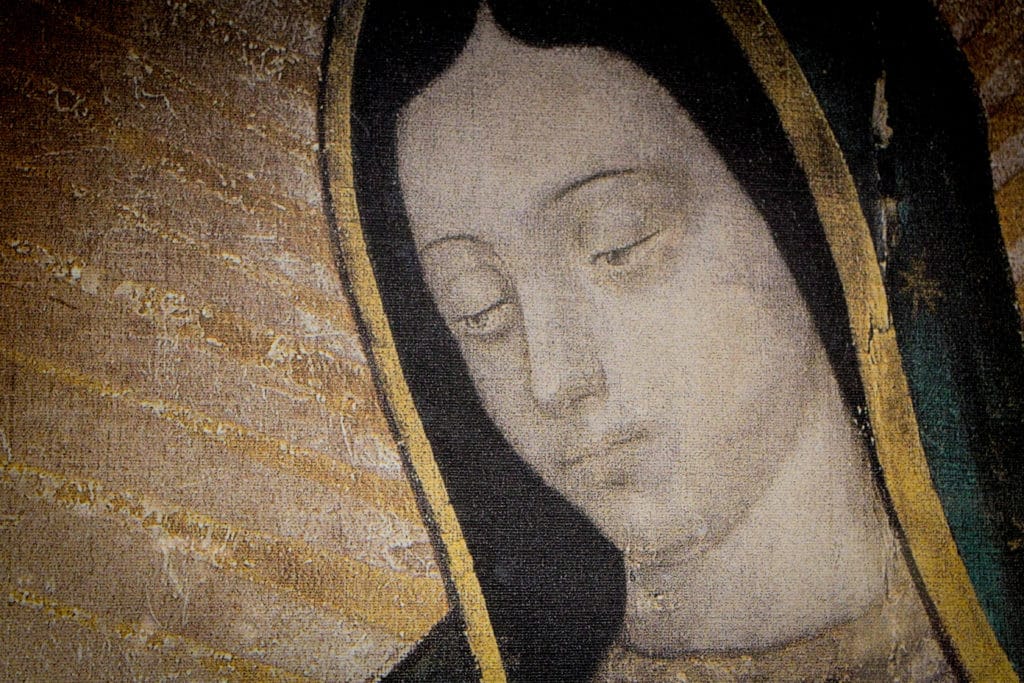On the morning of December 12, 1531, the winter solstice occurred. For the pre-Hispanic cultures, this told them, that the dwindling Sun was gaining strength, and a new one would arise… life would be revived! Precisely on this day the Aztecs celebrated the greatest feast… “The new fire”. Motolinia would call it “the Aztec Easter”, because where there is birth and resurrection, there is Easter. And on this day, Mary makes her last appearance, before Fray Juan de Zumarraga’s eyes, imprinting herself on Juan Diego’s tilma (cloak). And this became a festive day for Mexicans ever since.
Mary of Guadalupe’s encounters with Juan Diego
In the Nican Mopohua (account of the Virgin’s apparitions) the encounters between the Mother of Heaven and Juan Diego are narrated. There were four times, between December 9 and 12, and during her last visit, her image was imprinted on the tilma of this humble peasant. Since then, it has been possible to marvel at it just as we do to this day. It is amazing that, in spite of the centuries, the image has not undergone any important alterations. Those who know the Basilica of Guadalupe in Mexico will know what I am talking about.
A tilma that joins the Aztec people with Mary’s heart.
This image is undoubtedly a beautiful codex that Juan Diego could interpret immediately, because her dress, her hairstyle, her skin color, the color of her cloak, in short… her whole demeanor! held a Nahuatl message, and all this was recorded in a garment made of ixtle (maguey fibers) which the Indians used to protect themselves from the cold or to cover themselves from the sun and dust, or to carry the fruits of the harvest.
For the Aztecs, the tilma represented sustenance, protection, dignity, and it indicated social status. And that is exactly where the Mother of God wanted to imprint her image, not only so that we could admire the greatness of God in such a beautiful miracle, but she wanted to tell the world that we have a mother who sustains us with her tenderness, who protects us with her mantle and who makes us worthy when we feel her loving gaze. She is depicted in a tilma! offering her protection. Protection that goes beyond shelter and shadow… protection of body, soul, and heart!

Am I not here, who am your mother?
The Aztecs, faced with the Virgin’s beauty, surrender at her feet, because the Mother of God landed on Mexican soil as a beautiful Aztec maiden in order to bring hope to the Indigenous people, who suffered at that time being subjected to slavery by their conquerors, the destruction of their temples, the death of their people due to smallpox (disease brought by the Spanish) and the indifference of their gods when they realized that the sun rose every morning without the need to make human sacrifices.
Times do not change. How many times have we felt hopeless, like those Aztecs who felt their world was falling apart? Many times! But there She is, waiting to meet our gaze with hers, waiting for us to stretch out our arms so that she can hold us and whisper in our ear… “Am I not here, I who hold the honor and joy of being your mother? Are you not by chance in the embrace of my arms, in the hollow of my mantle? Am I not perhaps the source of your health? Am I not perhaps the source of your joy?”. (Text from the Nican Mopohua)

Mary’s tilma guides us to Jesus
This is how on a simple tilma of a Macehual peasant, a beautiful mestizo girl was drawn, carrying in her womb her beloved Son; the one who gave to the world his own flesh and blood, who holds us in his hands giving us the dignity that we sometimes think we have lost. He gave eternal life to humanity without the need for further human sacrifices because He had already sacrificed Himself for us. Mary of Guadalupe tells us: “Acknowledge this, my child, that I am the perfect and ever-virgin Mary”, mother “of the true God for whom we live”, “of the Creator of humankind”, “of the Owner of closeness and immediacy”, “of the Owner of heaven and earth”.



